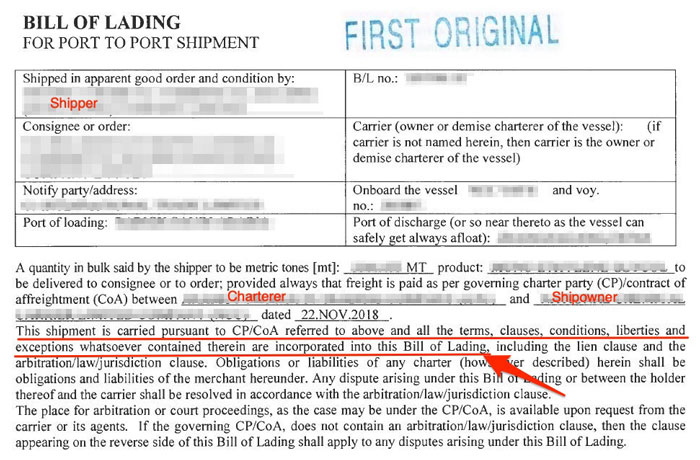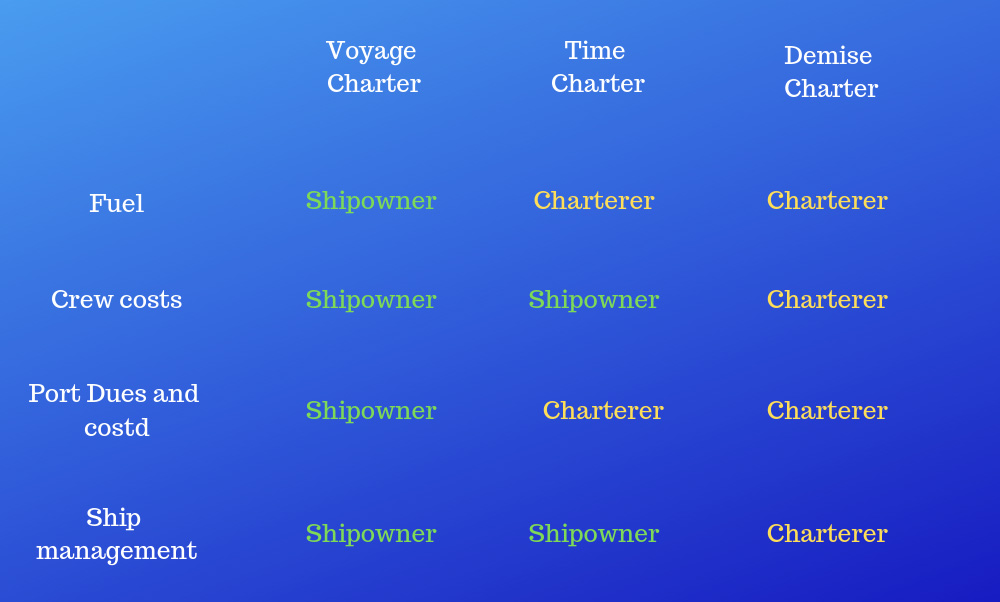
A Layman’s Guide to Laytime, Charter party Agreement and Voyage Charter

The word “Charterer” is probably as old as the word “Ship” itself. Do you keep hearing this word so regularly?
Well, who doesn’t?
From seafarer’s point of view, it is so much important to understand these terms.
Why?
From commercial point of view, it is the moral responsibility of the seafarers to ensure that the ship owner profits from the ship operation.
And for this reason, we must understand when and where our loyalties lies.
But sometimes it becomes difficult to get a hang of all of it. Not anymore.
In this blog, we will discuss about the terms charterer and charter party agreement.
Concept of Charter party agreement
It is all business. And like in all kind of business, there are at least two parties involved, one of which provide a service or product to the other for a price. With respect to carrying the cargo onboard the ships, these two parties are,
1) Ship owner who has the ship and provide the space on the ship to carry the cargo.
2) Shipper who has the cargo and wants a ship to transport the cargo

Then where does the term charterer fits into this?
Charterer is the party that has chartered (think of simple word “hired”) the ship.If the shipper has chartered the entire ship then shipper will also be the charterer.

In most of the cases, charterer is a kind of middle man between shipper(s) and shipowners This is particularly the case if there are more than one shippers.
For example, if the vessel is to load 50000 tons of cargo, there could be 10 shipper, say each of them with 5000 tons of cargo.
Alone none of the shipper would want to hire the entire vessel of 50000 tons capacity for their 5000 tons of cargo.
So they contact a charterer for transporting their cargo.
The charterer’s job is to find a vessel for the cargoes they have from different shippers and maximazing the space on ship they plan to hire.

Charterers may not be the only person involved in filling the gap between shipowner and shipper.
Sometime there are some other companies or persons who help shipper, charterer and shipowner to connect with each other for a fees.
They are called “Brokers”.
So the shipper’s broker is the person or company that help shipper find a charterer for a fees called brokerage. And charterer’s broker is the person that help charterer find a ship to hire.
The charterer may even have brokers for different purpose. For example charterer may have a broker to find a cargo for the ship they want to hire and they may have another broker to find a ship for the cargo they have in hand. Broker or no broker, the charterer and shipowner would agree on the terms and conditions which would form “Charter party agreement“.
Charter party agreement is a detailed document which, apart from various clauses, has informations such as
When and where the vessel is required to be the freight agreed
If the broker was used, who need to pay the brokerage fee and how much
Even though shipowners is primarily dealing with the charterer, it does not mean that the shipowner would have no relation with the shipper.
Shipper and shipowner are connected by the “carriage of cargo at sea act”, also called COGSA.
And one of the main point of it is that shipowner is required to issue bill of lading to the shipper for the cargo loaded onboard.
And with that each of the shipper have entered into an agreement with the ship owner which is called “Contract of carriage”.
While the “charter party agreement” is a formal agreement, the contract of carriage is governed by various laws and regulations such as Hague-Visby rule.
Charter party agreement supplement the contract of carriage.
Usually you would find a mention of the charter party agreement in the bill of lading. The wording in the bill of lading could be something like this.
This shipment is carried pursuant to charter party agreement between “Charterer’s name” and “Carrier’s name” and all the terms, clauses, conditions, liberties and exceptions whatsoever contained therein are incorporated into this bill of lading.

But do the shipowners and charterers do this exercise of negotiating the format of the charter party agreement each time they do the business together.
Absolutely not. Hell, it would take a lot of time.
Instead they use pre-defined forms. These forms are developed by Independent International stakeholders such as BIMCO and INTERTANKO and are widely used in the shipping business.
There are different forms for different trades.
For example there is form SHELLVOY 6 for use in tanker trade and then there is form AMWELSH 93 for coal dry cargo chartering.
Also if a charterer and ship owner have done the business before, they use the same charter party agreement for the future shipments too.
For this reason, many a times even for a voyage in 2019, you may find the mention of charter party dated in 2016 or even before. In the bill of lading issued even in 2019 , it may read something like,
The shipment is carried pursuant to charter party agreement between “Charterer’s name” and “Carrier’s name” dated 01 January 2016…..
Now that we understand the concept of chartering, let us understand the different ways in which the ships can be chartered.
Voyage Charter, Time charter, Demise charter
There are different ways in which a charterer can charter (Hire) the vessel.
Charterer can charter the vessel for one voyage (Voyage charter), for a particular time period (time charter) or they can hire and run the vessel as if they are the owner of the vessel (Demise or bareboat charter).
In each type of charter, charterers and shipowners have different area of responsibilities.
Each type of charter is a subject in itself. So in this blog we will explore the voyage charter.

Voyage Charter
It should be clear from the name. Under the voyage charter, the ship is hired from the ship owner for one voyage. One voyage could consists of multiple load ports and multiple discharge port. The best analogy to the term voyage charter is that with hiring an Uber for a ride from one place to the other, sometimes with multiple stops in between. So when we hire an Uber, we hire just the cab. The cab driver is still under the instructions of Uber.
Similarly, under the voyage charter, the charterer has hired the ship’s cargo space. But the Master and crew still remains under the disposal and instructions of ship owner and ship managers. When we hire a cab for a ride, we just pay the hire (pre-agreed or by the meter). We do not pay for or are not concerned about the fuel costs or the amount of fuel consumed.
Similarly, under the voyage charter, charterer is not concerned about the fuel consumption. The fuel costs are for the ship owners. And when we hire an Uber, we do not pay for maintenance of the cab. Similarly, under the voyage charter it is the ship owner who pays for the maintenance of the ship. Whenever we have any doubt about anything under voyage charter, just think of this analogy of hiring the cab.
Laytime, Demurrage and despatch
Lord Diplock during one of the leading cases on Laytime described the voyage charter party comprising of four stages.
- Stage 1 is the loading voyage: The voyage from wherever the ship is to the loading port specified in the voyage charter party
- Stage 2 is the Loading operation: The loading of the cargo at the port of loading
- Stage 3 is the carrying voyage: The voyage from load port to the discharge port specified in the voyage charter party.
- Stage 4 is the discharging operation: The discharging of the cargo from the ship to the port of discharging as specified in the voyage charter party.e
In the first and third stage, it is only the ship owner that need to perform. For example. ship owner is required to adjust the speed of the ship to arrive at the loading port within the agreed dates (Laycan).
